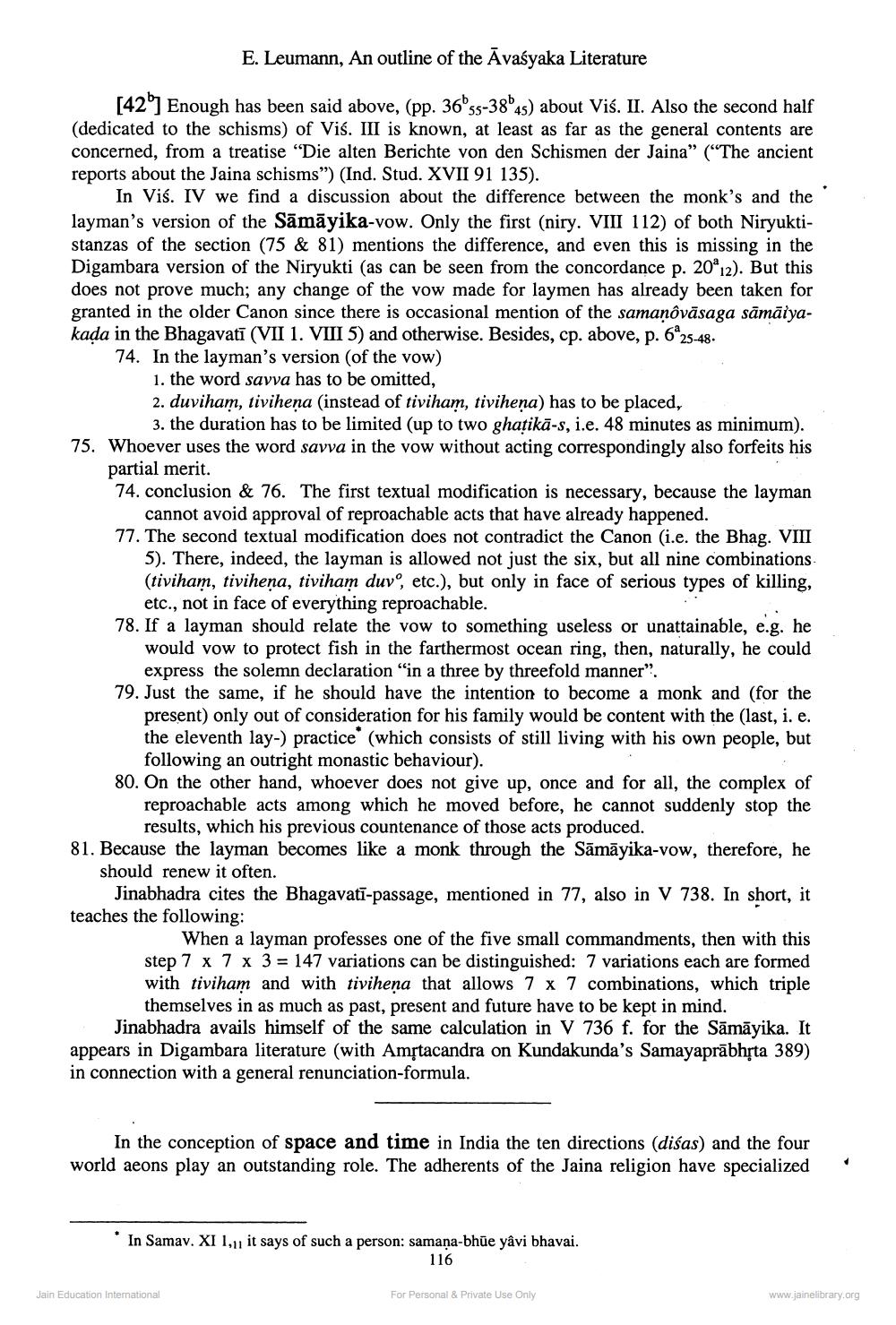________________
E. Leumann, An outline of the Avaśyaka Literature
[42] Enough has been said above, (pp. 36'55-38 45) about Viś. II. Also the second half (dedicated to the schisms) of Viś. III is known, at least as far as the general contents are concerned, from a treatise “Die alten Berichte von den Schismen der Jaina" ("The ancient reports about the Jaina schisms”) (Ind. Stud. XVII 91 135).
In Viś. IV we find a discussion about the difference between the monk's and the layman's version of the Sāmāyika-vow. Only the first (niry. VIII 112) of both Niryuktistanzas of the section (75 & 81) mentions the difference, and even this is missing in the Digambara version of the Niryukti (as can be seen from the concordance p. 20°12). But this does not prove much; any change of the vow made for laymen has already been taken for granted in the older Canon since there is occasional mention of the samaņôvāsaga sāmāiyakada in the Bhagavati (VII 1. VIII 5) and otherwise. Besides, cp. above, p. 625-48. 74. In the layman's version (of the vow)
1. the word savva has to be omitted, 2. duviham, tivihena (instead of tiviham, tivihena) has to be placed,
3. the duration has to be limited (up to two ghatikā-s, i.e. 48 minutes as minimum). 75. Whoever uses the word savva in the vow without acting correspondingly also forfeits his
partial merit. 74. conclusion & 76. The first textual modification is necessary, because the layman
cannot avoid approval of reproachable acts that have already happened. 77. The second textual modification does not contradict the Canon (i.e. the Bhag. VIII
5). There, indeed, the layman is allowed not just the six, but all nine combinations (tiviham, tivihena, tiviham duv, etc.), but only in face of serious types of killing,
etc., not in face of everything reproachable. 78. If a layman should relate the vow to something useless or unattainable, e.g. he
would vow to protect fish in the farthermost ocean ring, then, naturally, he could
express the solemn declaration "in a three by threefold manner". 79. Just the same, if he should have the intention to become a monk and (for the
present) only out of consideration for his family would be content with the (last, i. e. the eleventh lay-) practice (which consists of still living with his own people, but
following an outright monastic behaviour). 80. On the other hand, whoever does not give up, once and for all, the complex of
reproachable acts among which he moved before, he cannot suddenly stop the
results, which his previous countenance of those acts produced. 81. Because the layman becomes like a monk through the Sāmāyika-vow, therefore, he
should renew it often.
Jinabhadra cites the Bhagavatī-passage, mentioned in 77, also in V 738. In short, it teaches the following:
When a layman professes one of the five small commandments, then with this step 7 x 7 x 3 = 147 variations can be distinguished: 7 variations each are formed with tiviham and with tivihena that allows 7 x 7 combinations, which triple
themselves in as much as past, present and future have to be kept in mind.
Jinabhadra avails himself of the same calculation in V 736 f. for the Sāmāyika. It appears in Digambara literature (with Amstacandra on Kundakunda's Samayaprābhịta 389) in connection with a general renunciation-formula.
In the conception of space and time in India the ten directions (diśas) and the four world aeons play an outstanding role. The adherents of the Jaina religion have specialized
In Samav. XI 1,11 it says of such a person: samaņa-bhüe yâvi bhavai.
116
Jain Education International
For Personal & Private Use Only
www.jainelibrary.org




